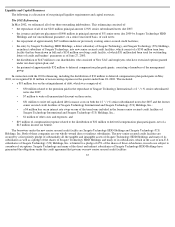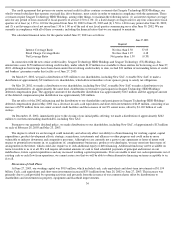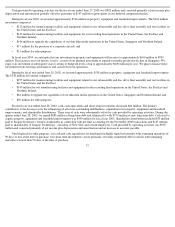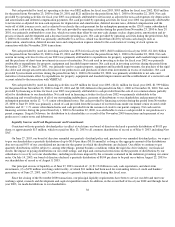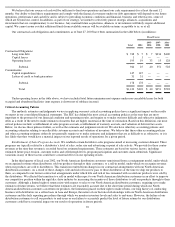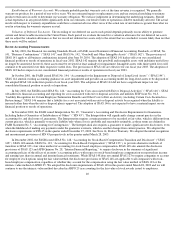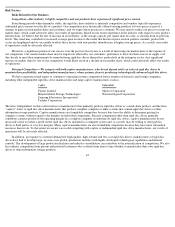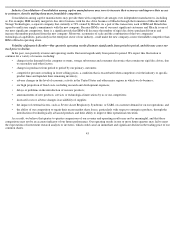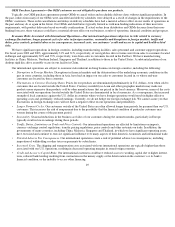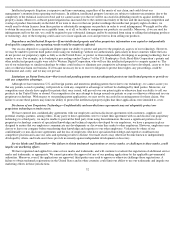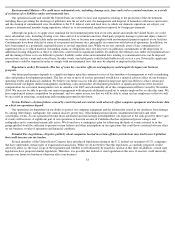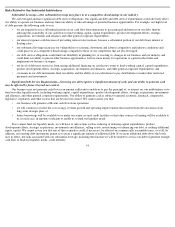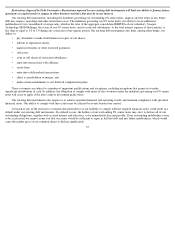Seagate 2002 Annual Report Download - page 50
Download and view the complete annual report
Please find page 50 of the 2002 Seagate annual report below. You can navigate through the pages in the report by either clicking on the pages listed below, or by using the keyword search tool below to find specific information within the annual report.
•
the impact of changes in foreign currency exchange rates on the cost of producing our products and the effective price of our
products to foreign consumers; and
Variable Product Life Cycles—The variability of product life cycles can make planning product transitions difficult.
•
operational issues arising out of the increasingly automated nature of our manufacturing processes.
Historically the rate of increase of areal density has grown rapidly; however, recently this rate of increase is slowing. Higher areal
densities mean that fewer read/write heads and rigid discs are required to achieve a given rigid disc drive storage capacity. In addition,
advances in computer hardware and software have led to the demand for successive generations of storage products with increased storage
capacity and/or improved performance and reliability. As a result, product life cycles shortened because of recent rapid increases in areal
density. The introduction of new rigid disc drives requires us to engage in new product qualifications with our customers and we expect to
engage in several competitive product qualifications during the balance of this calendar year, particularly with respect to our notebook
products, and on an ongoing basis in future years. Short product cycles make it more difficult to recover the cost of product development
because those costs must be recovered over increasingly shorter periods of time during the life cycles of products.
In contrast to historical trends, based on our recent experience in the industry with respect to new product introductions, we believe that
the current rate of increase in areal density is slowing from the rate of the last several years. We believe that this slowdown in the rate of
increase in areal density will continue until a significant advance in technology for the electronic storage of data, such as perpendicular
recording technology, becomes commercially available. When the rate of increase in areal density slows, it may contribute to increased average
price erosion to the extent historical price erosion patterns continue, product life cycles are lengthened and our ability to introduce new
products at higher prices is limited. In addition, the variability of product life cycles can make planning product transitions more difficult. To
the extent that we prematurely discontinue a product, or do not timely introduce new products, our operating results may be adversely affected.
New Product Offerings—Market acceptance of new product introductions cannot be accurately predicted, and our results of
operations will suffer if there is less demand for our new products than is anticipated.
We are continually developing new products in the hope that we will be able to introduce technologically advanced rigid disc drives into
the marketplace ahead of our competitors. The success of our new product introductions is dependent on a number of factors, including market
acceptance, our ability to manage the risks associated with product transitions, the effective management of inventory levels in line with
anticipated product demand, and the risk that our new products will have quality problems or other defects in the early stages of introduction
that were not anticipated in the design of those products. Accordingly, we cannot accurately determine the ultimate effect that our new products
will have on our sales or results of operations.
In addition, the success of our new product introductions is dependent upon our ability to qualify as a primary source of supply with our
original equipment manufacturer, or OEM, customers. In order for our products to be considered by our customers for qualification, we must
be among the leaders in time-to-
market with those new products. Once a product is accepted for qualification testing, any failure or delay in the
qualification process can result in our losing sales to that customer until new products are introduced. The effect of missing a product
qualification opportunity is magnified by the limited number of high-volume OEMs. These risks are further magnified because we expect
competitive pressures to result in declining sales and declining gross margins on our current generation products. We cannot assure you that we
will be among the leaders in time-to-market with new products or that we will be able to successfully qualify new products with our customers
in the future.
Smaller Form Factor Rigid Disc Drives—If we do not successfully market smaller form factor rigid disc drives, our business may
suffer.
Increases in sales of notebook computers and in areal density are resulting in a shift to smaller form factor rigid disc drives for an
expanding number of applications, including PCs, enterprise storage applications and consumer electronics. These applications have typically
used rigid disc drives with a 3.5-inch form factor, which we currently manufacture. Notebook computers typically use 2.5-inch form factor
rigid disc drives. Although we are currently shipping notebook drives to OEMs, we currently have not completed qualification programs with a
number of OEMs which are material to the success of these products. Furthermore, our announced products only address a limited portion of
the existing notebook market. We cannot assure you that we will receive additional qualifications or that we will be able to successfully
compete in the market for smaller form factor rigid disc drives. If we do not suitably adapt our technology and product offerings to successfully
develop and introduce smaller form factor rigid disc drives, customers may decrease the amounts of our products that they purchase.
45


